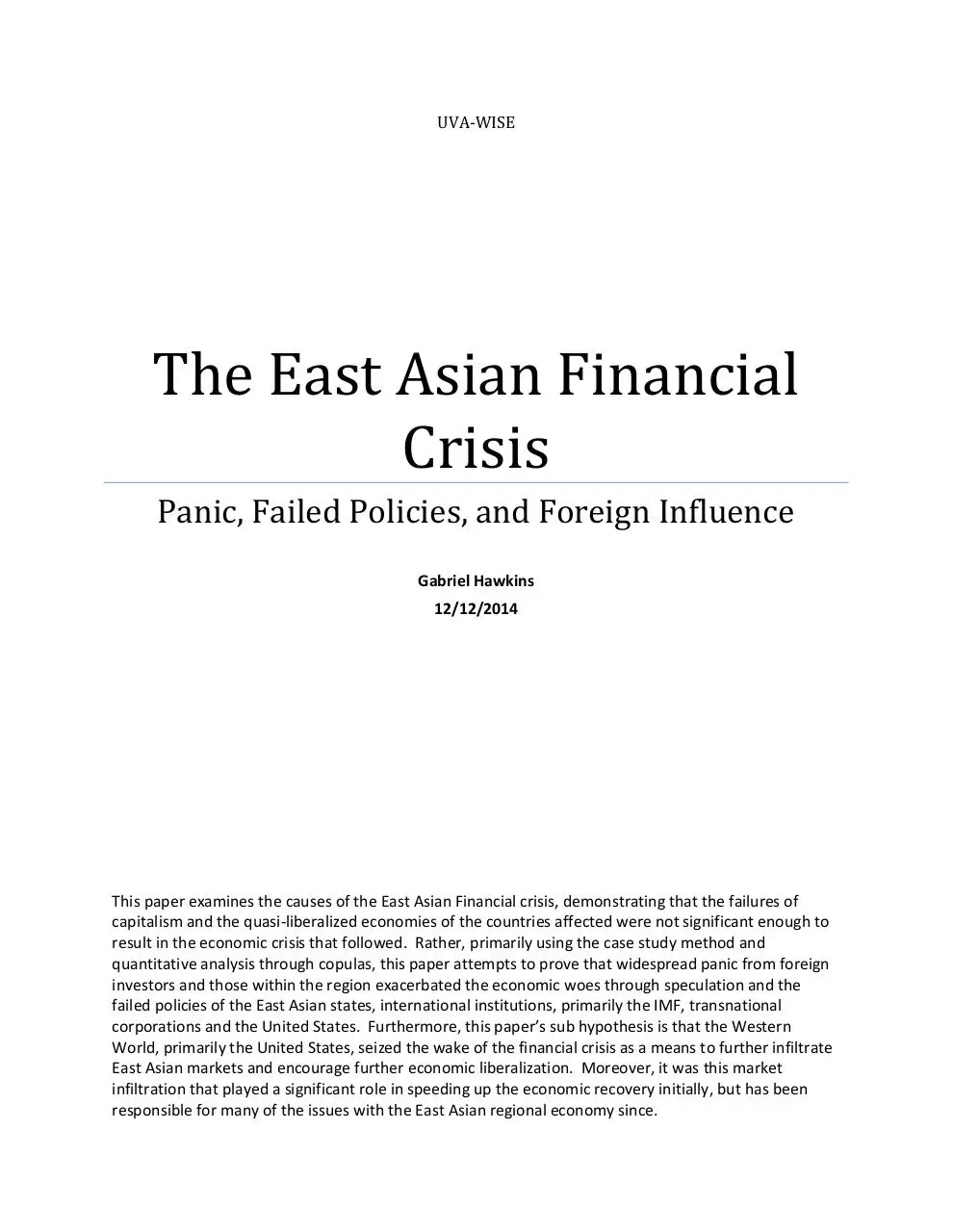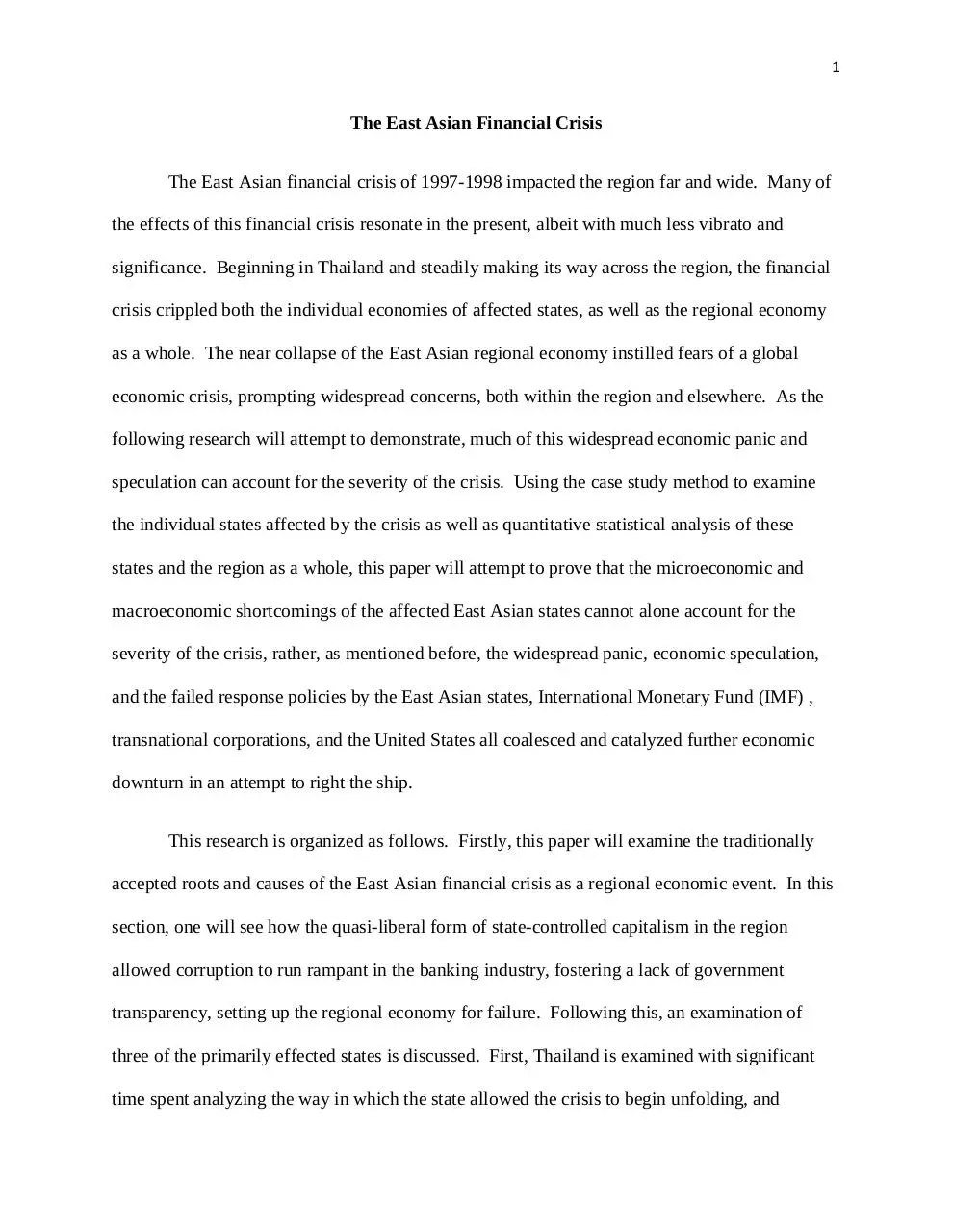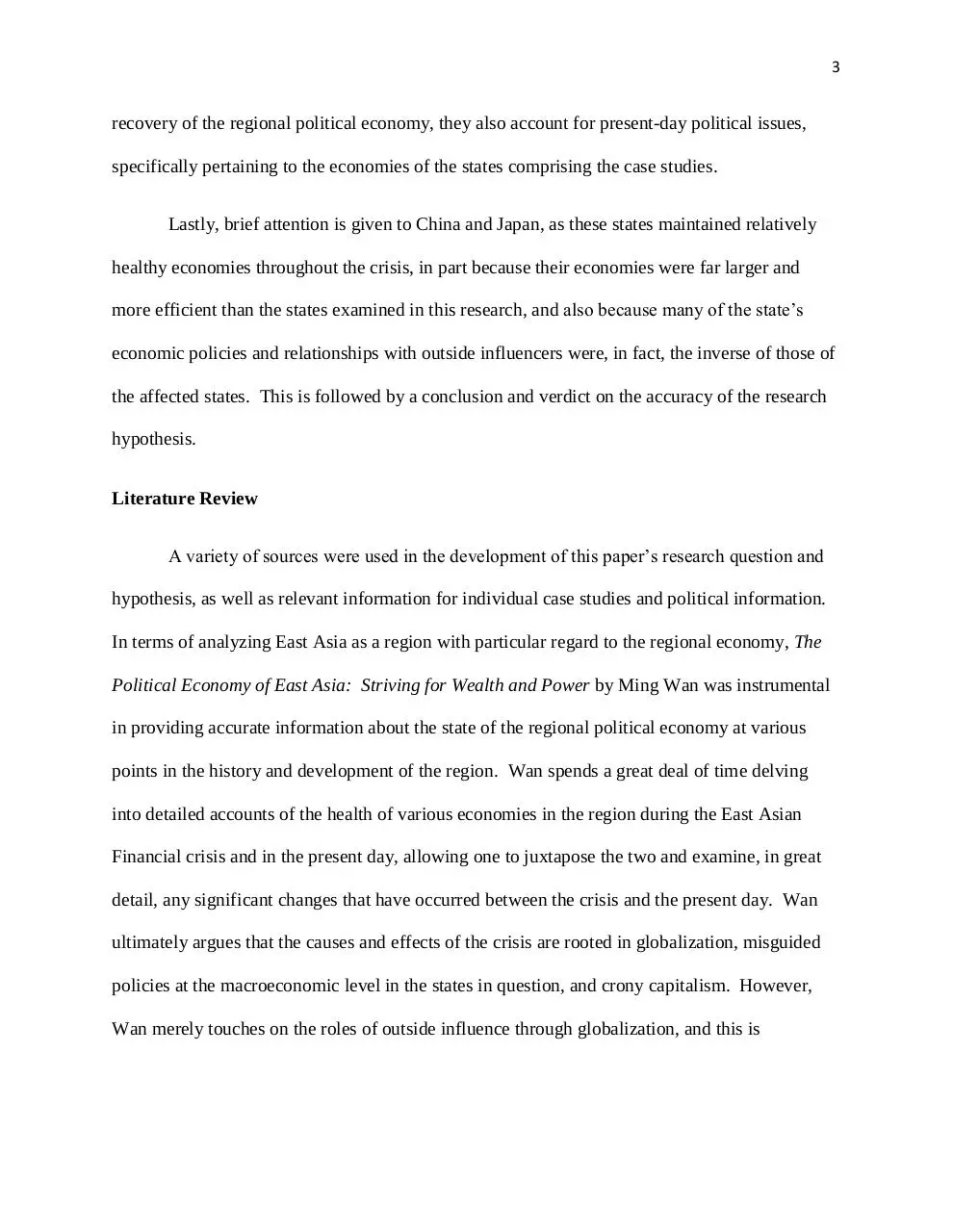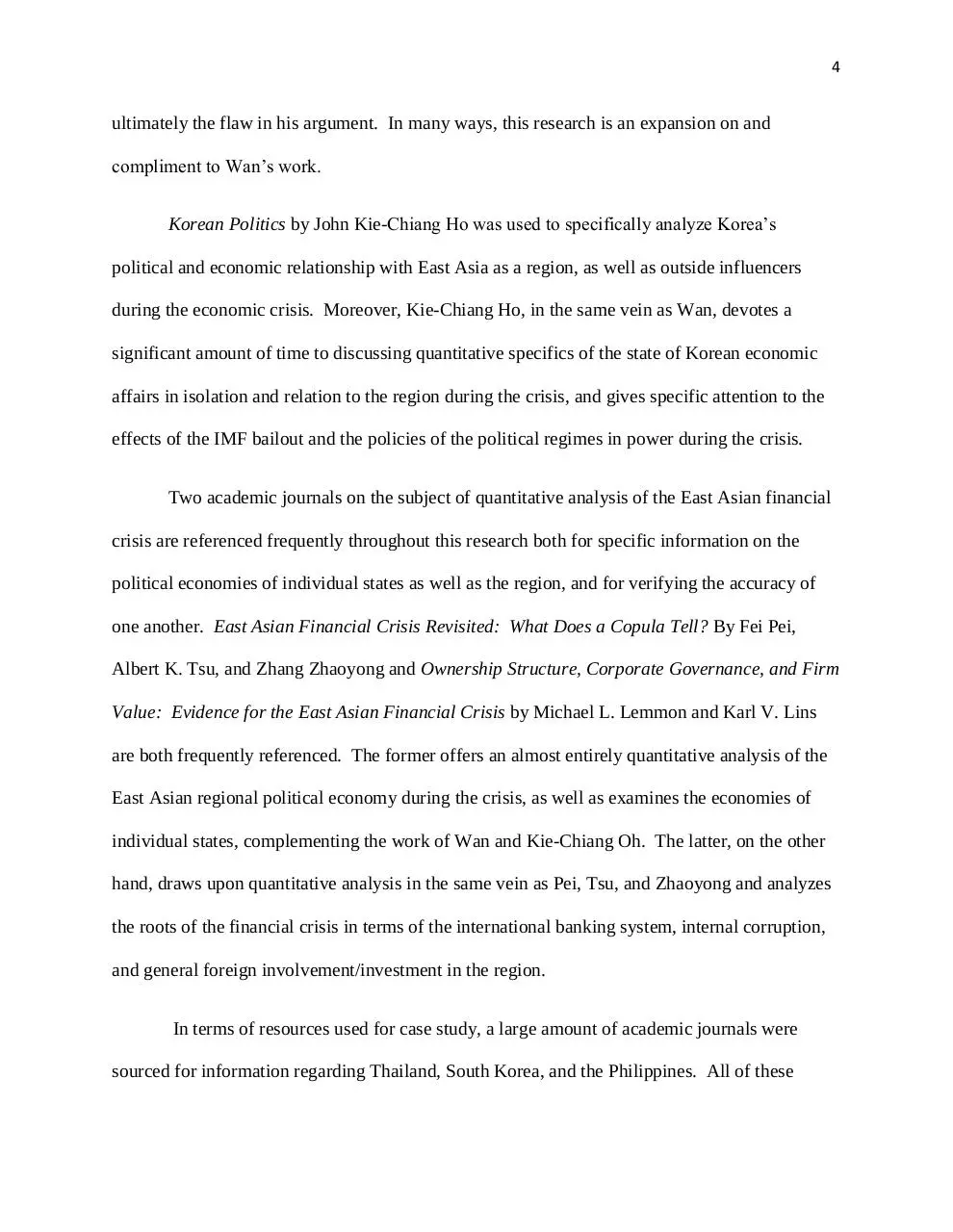East Asian Financial Crisis (PDF)
File information
Title: The East Asian Financial Crisis
Author: Gabriel Hawkins
This PDF 1.5 document has been generated by Microsoft® Word Starter 2010, and has been sent on pdf-archive.com on 11/07/2015 at 20:22, from IP address 72.66.x.x.
The current document download page has been viewed 702 times.
File size: 685.74 KB (33 pages).
Privacy: public file





File preview
UVA-WISE
The East Asian Financial
Crisis
Panic, Failed Policies, and Foreign Influence
Gabriel Hawkins
12/12/2014
This paper examines the causes of the East Asian Financial crisis, demonstrating that the failures of
capitalism and the quasi-liberalized economies of the countries affected were not significant enough to
result in the economic crisis that followed. Rather, primarily using the case study method and
quantitative analysis through copulas, this paper attempts to prove that widespread panic from foreign
investors and those within the region exacerbated the economic woes through speculation and the
failed policies of the East Asian states, international institutions, primarily the IMF, transnational
corporations and the United States. Furthermore, this paper’s sub hypothesis is that the Western
World, primarily the United States, seized the wake of the financial crisis as a means to further infiltrate
East Asian markets and encourage further economic liberalization. Moreover, it was this market
infiltration that played a significant role in speeding up the economic recovery initially, but has been
responsible for many of the issues with the East Asian regional economy since.
1
The East Asian Financial Crisis
The East Asian financial crisis of 1997-1998 impacted the region far and wide. Many of
the effects of this financial crisis resonate in the present, albeit with much less vibrato and
significance. Beginning in Thailand and steadily making its way across the region, the financial
crisis crippled both the individual economies of affected states, as well as the regional economy
as a whole. The near collapse of the East Asian regional economy instilled fears of a global
economic crisis, prompting widespread concerns, both within the region and elsewhere. As the
following research will attempt to demonstrate, much of this widespread economic panic and
speculation can account for the severity of the crisis. Using the case study method to examine
the individual states affected by the crisis as well as quantitative statistical analysis of these
states and the region as a whole, this paper will attempt to prove that the microeconomic and
macroeconomic shortcomings of the affected East Asian states cannot alone account for the
severity of the crisis, rather, as mentioned before, the widespread panic, economic speculation,
and the failed response policies by the East Asian states, International Monetary Fund (IMF) ,
transnational corporations, and the United States all coalesced and catalyzed further economic
downturn in an attempt to right the ship.
This research is organized as follows. Firstly, this paper will examine the traditionally
accepted roots and causes of the East Asian financial crisis as a regional economic event. In this
section, one will see how the quasi-liberal form of state-controlled capitalism in the region
allowed corruption to run rampant in the banking industry, fostering a lack of government
transparency, setting up the regional economy for failure. Following this, an examination of
three of the primarily effected states is discussed. First, Thailand is examined with significant
time spent analyzing the way in which the state allowed the crisis to begin unfolding, and
2
moreover, the way in which it allowed the crisis to spread to other parts of the region.
Additionally, quantitative statistical analysis will demonstrate that the economic shortcomings of
Thailand were greatly exaggerated leading to panic and intense speculation, amplifying the
economic downturn and further catalyzing its spread elsewhere. Next, the economy of the
Philippines is examined, first as a state in which the economic crisis “spilled over” from
Thailand, and then as an individual economy. The Philippines also demonstrates both the
negative and positive effects of foreign involvement in the economies of East Asia in an attempt
to rectify the issues stemming from the crisis, primarily in the form of U.S. and IMF
intervention. Lastly, South Korea is examined, much like the former states, first as an economy
affected by East Asia’s regionalism and the spillover of the crisis, then as an individual
economy. Detailed examination of the Korean economy demonstrates the high level of
speculation, panic, and exaggeration that the region fell victim to during the crisis, as its overall
economic health, even in the midst of the crisis, was nowhere as negative as was being
portrayed. In each of these case studies, particular attention is given to specific policies that
were passed both by the state or implemented by outside influence and the effects that these
policies had on the individual and regional economy.
Following these individual case studies, the conclusions of each will be taken together to
paint a more accurate picture of the economic condition of East Asia as a regional political
economy and, as this paper hypothesizes, will demonstrate that panic, speculation, and failed
political and economic policies were what truly accounted for the crisis. This picture will then
be used as a framework from which to analyze the way in which foreign involvement in the
economies of the region in the wake of the crisis has affected them in the present. This paper
will argue that, although many of the actions taken by outside influencers aided in a faster
3
recovery of the regional political economy, they also account for present-day political issues,
specifically pertaining to the economies of the states comprising the case studies.
Lastly, brief attention is given to China and Japan, as these states maintained relatively
healthy economies throughout the crisis, in part because their economies were far larger and
more efficient than the states examined in this research, and also because many of the state’s
economic policies and relationships with outside influencers were, in fact, the inverse of those of
the affected states. This is followed by a conclusion and verdict on the accuracy of the research
hypothesis.
Literature Review
A variety of sources were used in the development of this paper’s research question and
hypothesis, as well as relevant information for individual case studies and political information.
In terms of analyzing East Asia as a region with particular regard to the regional economy, The
Political Economy of East Asia: Striving for Wealth and Power by Ming Wan was instrumental
in providing accurate information about the state of the regional political economy at various
points in the history and development of the region. Wan spends a great deal of time delving
into detailed accounts of the health of various economies in the region during the East Asian
Financial crisis and in the present day, allowing one to juxtapose the two and examine, in great
detail, any significant changes that have occurred between the crisis and the present day. Wan
ultimately argues that the causes and effects of the crisis are rooted in globalization, misguided
policies at the macroeconomic level in the states in question, and crony capitalism. However,
Wan merely touches on the roles of outside influence through globalization, and this is
4
ultimately the flaw in his argument. In many ways, this research is an expansion on and
compliment to Wan’s work.
Korean Politics by John Kie-Chiang Ho was used to specifically analyze Korea’s
political and economic relationship with East Asia as a region, as well as outside influencers
during the economic crisis. Moreover, Kie-Chiang Ho, in the same vein as Wan, devotes a
significant amount of time to discussing quantitative specifics of the state of Korean economic
affairs in isolation and relation to the region during the crisis, and gives specific attention to the
effects of the IMF bailout and the policies of the political regimes in power during the crisis.
Two academic journals on the subject of quantitative analysis of the East Asian financial
crisis are referenced frequently throughout this research both for specific information on the
political economies of individual states as well as the region, and for verifying the accuracy of
one another. East Asian Financial Crisis Revisited: What Does a Copula Tell? By Fei Pei,
Albert K. Tsu, and Zhang Zhaoyong and Ownership Structure, Corporate Governance, and Firm
Value: Evidence for the East Asian Financial Crisis by Michael L. Lemmon and Karl V. Lins
are both frequently referenced. The former offers an almost entirely quantitative analysis of the
East Asian regional political economy during the crisis, as well as examines the economies of
individual states, complementing the work of Wan and Kie-Chiang Oh. The latter, on the other
hand, draws upon quantitative analysis in the same vein as Pei, Tsu, and Zhaoyong and analyzes
the roots of the financial crisis in terms of the international banking system, internal corruption,
and general foreign involvement/investment in the region.
In terms of resources used for case study, a large amount of academic journals were
sourced for information regarding Thailand, South Korea, and the Philippines. All of these
5
sources may be found on the reference page of this paper. Many of these journals provided small
or supporting details to the overall research, however, a few key journals of note were sourced
frequently for these case studies. The Philippine Economy in the Face of External Shocks by
Maria Socorro Gochoco-Bautista, Contingent Political Capital and International Alliances:
Evidence from South Korea by Jordan Siegel, and Financial Systems in Developing Economies:
Growth, Inequality, and Policy Evaluation in Thailand by Robert M. Townsend all provided a
wide range of details pertaining to the political economies, state policies, and the interactions
with foreign influencers of each of the case study states. In each of these sources, the role
globalization played in the development of the crisis is discussed, giving credence to the
legitimacy of the hypothesis of this research.
A variety of other sources, primarily academic journals courtesy of Ebscohost, were used
in varying capacities to provide supplementary and complimentary information for this research,
verify and cross reference the aforementioned sources, as well as to provide smaller, yet
important details about the political economy of East Asia and/or the states analyzed for the case
studies, but were not used frequently enough to warrant mention here. However, each of these
sources may be found on the reference page of this document.
Methodology
As stated before, the primary methodology behind this research is the case study, coupled
with intense quantitative analysis of the economies of the states examined in these case studies,
as well as qualitative inferences regarding the effects of policy, panic, and speculation in the
exacerbation of the economic woes of the East Asian political economy during the financial
crisis. In choosing the countries for case study, each one was chosen for its specific and unique
6
role, response, and interaction with the financial crisis and outside influencers. Thailand was
chosen because it is generally considered to be the state in which the crisis began. Additionally,
Thailand had frequent interactions with the International Monetary Fund (IMF) in the wake of
the crisis. The Philippines was chosen due to its rapidly growing economy at the onset of the
crisis, as well as its close ties with the United States in terms of a political and economic
relationship. The Philippines demonstrates the role this type of relationship and interaction had
on the outcome of the financial crisis as well as its long term effects. Lastly, South Korea was
chosen because of its economic health throughout the duration of the crisis. In terms of raw
GDP and overall quality of life, South Korea, though certainly affected by the crisis, largely
retained its status as a strong economy relative to the other affected states in the region. South
Korea also played a significant role in international finance and investment, giving it a unique
interaction with these outside influencers that is notable throughout the crisis. In taking each of
these states together, one can see that the regional political economy was nowhere near as badly
damaged as was feared, and it was not until a series of political and economic policies and
decisions were implemented that the downturn truly took place.
The specific quantitative data analyzed for this paper is largely based on statistical
models created through a variety of copulas using information limited to the period between
January 3rd 1994 and December 31, 2004 with specific note and attention given to the 1997-1998
period of financial crisis in the region. This information is then compared to more simplistic
measurements of GDP, quality of life, and other nascent features of the regional and state-bystate political economies. The primary source for copula data is Fei, Tsui, and Zhong source
mentioned in the literature review section of this document as well as the references page.
7
The sub-hypothesis of this research is that, in the wake of the crisis, the United States and
smaller players in the West seized the opportunity to implement further globalization through
market infiltration and the encouragement of further economic liberalization in the region. The
states chosen for case study all have specific interactions with the United States, and/or other
international players, primarily from the Western world, that demonstrate this correlation.
Coupled with the quantitative data analyzed by this research, a verdict as to the accuracy of this
hypothesis can be made.
In terms of determining the accuracy of the first hypothesis, the conclusion will rank the
validity as a true-false statement as follows:
True – the hypothesis was thoroughly tested by a variety of sources and
information, and insofar as is it is reasonably argued, the hypothesis has been
proven accurate and true.
Plausible – the hypothesis, though thoroughly tested, required further
examination and testing of intervening variables with a variety of sources to
render a true/false verdict. The information provided suggests that the hypothesis
may or may not be true.
False – after thorough testing, the hypothesis has been demonstrated to have little
to no impact on the findings of this research and, insofar as it is reasonably
argued, the hypothesis has been proven inaccurate and false.
On the other hand, the sub-hypothesis of this paper can only be reasonably demonstrated through
a correlative relationship due to the logistical constraints of this research. As such, the validity
of the sub-hypothesis will be determined through a strength of correlation matrix, as follows.
8
Strong Correlation – this research suggests a correlation to such a degree that
the likelihood that market infiltration and promotion of further liberalization of
the East Asian political economy by the United States and other foreign actors has
had a direct impact on present day economic issues in the region is almost certain.
Moderate Correlation – this research suggests that, though a correlation may be
present to a notable degree, market infiltration by the United States and other
foreign actors is unlikely the primary source of the present day economic issues in
the East Asian political economy.
Weak Correlation – this research suggests that market infiltration and promotion
of further liberalization of the economies of East Asian polities has impacted
present-day economic issues to some degree, but ultimately does not account for
any significant effects.
No Correlation – this research suggests that there exists no evidence that market
infiltration by outside influencers has impacted present-day economic issues in
the East Asian political economy.
Terms and Definitions
The definitions of a few key terms as they are used throughout this research is
fundamental to properly understand the information provided, arguments made, and conclusions
developed in this paper.
1. Panic – In this paper, panic refers to sudden withdrawal of funds by foreign
investors perceiving a higher than normal economic risk to maintain their
investments.
Download East Asian Financial Crisis
East Asian Financial Crisis.pdf (PDF, 685.74 KB)
Download PDF
Share this file on social networks
Link to this page
Permanent link
Use the permanent link to the download page to share your document on Facebook, Twitter, LinkedIn, or directly with a contact by e-Mail, Messenger, Whatsapp, Line..
Short link
Use the short link to share your document on Twitter or by text message (SMS)
HTML Code
Copy the following HTML code to share your document on a Website or Blog
QR Code to this page

This file has been shared publicly by a user of PDF Archive.
Document ID: 0000286157.